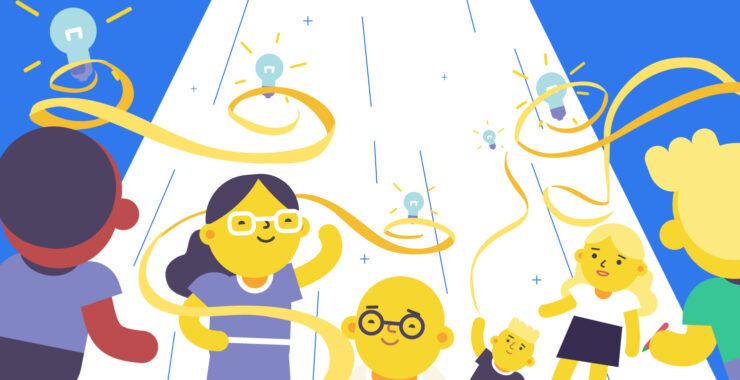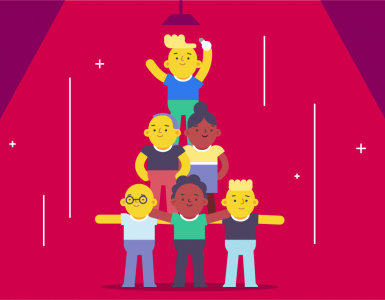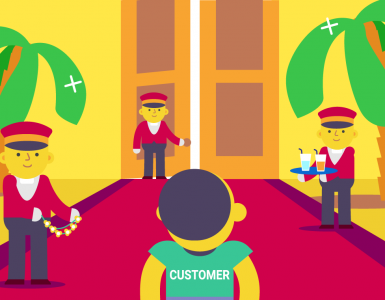Brainstorming sessions are thought to occur mainly in tech company settings. After all, that’s how they come up with all of those ideas for new apps, right? In reality, many businesses take advantage of brainstorming. It helps them come up with new products and services, as well as ways to market their already existing products.
If your company’s brainstorming techniques end up with poor results, then it’s time to branch out and try some of these effective brainstorming techniques. Your employees might just come up with some excellent money making ideas.
Brainstorming definition
According to Whatis.com, brainstorming is a technique for solving problems that entails an unplanned series of suggestions and answers.
This method calls for a lengthy, rambunctious discussion in which each group member is encouraged to think aloud and offer as many ideas as they can based on their varied knowledge.
Brainstorming combines lateral thinking, a technique for creating new ideas to solve issues by taking a fresh look at them, with an informal approach to problem-solving. Some of these concepts can be incorporated into novel, inventive responses to issues, while others can spark new concepts.
The Importance of Preparation for Effective Brainstorming
A good brainstorming session doesn’t just happen – it has to be orchestrated and preconditioned. While it would seem that brainstorming was just a free exchange of ideas, the fact is, prepositioning makes all the difference between a chaotic conversation and a session brimming with brilliant ideas.
It is not overplanning or stifling creativity – it’s just that preparation creates the right environment and focus for ideas to blossom. Imagine attempting to construct a house without a step preceding the gathering of your tools: frustrating, unproductive, and messy. Well, brainstorming isn’t much different. A little groundwork goes a long way.
Here are ways in which preparation can make your brainstorming sessions more effective.
- Set clear goals: Before taking the plunge, define what you are trying to achieve. Are you going to brainstorm a new marketing strategy? A product design? A solution to a thorny problem? Having clear objectives gives your team a sense of direction and keeps the discussion on track.
- Create a comfortable environment: The physical space can greatly impact creativity. Find an environment that is relaxed, free from distractions, quiet, and comfortable – be it a quiet conference room, a cozy lounge, or even an outdoor space. The aim is to create an atmosphere where ideas can flow freely.
- Provide the right tools: Be prepared with materials like whiteboards, sticky notes, or brainstorming software to make the process easier. These tools will help bring the ideas out quickly in a very visual way to keep everyone engaged and organized.
- Share the agenda beforehand: Let them know what to expect. Even a simple email with the purpose and goals of the session can help the participants come prepared with thoughts and ideas, which in turn jump-starts the conversation.
- Prime the team with context: Share background information or examples to get everyone on the same page. Whether it’s market research, customer feedback, or competitor analysis, context helps bring forth relevant and innovative ideas.
When your team is well-prepared, brainstorming is less about scrambling for ideas and more about building on a solid foundation. Preparation doesn’t stifle creativity – it unlocks it. You create space and focus for your team to think freely, to collaborate effectively, and come up with those truly great ideas by laying the groundwork.
8 Brainstorming techniques
When a brainstorming session is successful, the team can feel productive, successful, and eager for the next steps.
The use of efficient brainstorming can facilitate the feeling of accomplishment among employees. On the other hand, if a brainstorming session doesn’t work it may feel negative, repetitive, or useless for the as a whole.
Here are some steps that you can take to improve brainstorming within your team:
1. Step outside your office
Staying inside is anathema to coming up with creative ideas. Your employees face the same four walls, day in and day out. This makes creativity hard to come by. If you really want them to come up with some great brainstorming techniques, then you need to encourage employees to literally step outside the box.
For example, if you’re trying to develop a new product, have them go to the store and look at existing models. Or just let them spend some time walking around outside before the session begins. This physical energy often awakens mental creativity and boosts productivity.
2. Write down ideas no matter how crazy they seem
This is one of the most popular brainstorming techniques.
Sometimes one idea leads to another—even if that first idea is unreasonable and rather off the wall. However, if you don’t write these ideas down, they might be easily forgotten. It doesn’t matter what you write them down on; everything from a large whiteboard to a piece of paper or even a shared Google document will work.
What matters is that they’ll be saved for people to use later. You never know what might develop. The more ideas, the better, even if some of them seem outlandish at first.
3. Set up some general ground rules that aren’t overly strict
A good brainstorming session shouldn’t be a free for all. Yes, people tend to get excited and talk over each other, but that can actually cause discord within the group. This can lead to people being afraid to speak up.
In order to prevent these situations, you need to set up some general ground rules. They can be as simple as “only one person talks at a time” or “don’t disparage other people’s ideas.” You can even choose unusual, somewhat existential rules like “go with the flow” and “be visual with your thoughts.” Just make sure that everyone in the brainstorming session knows about the rules before they get started.
4. Add some toys and physical objects to the room
Studies have shown that people think better when they have something in their hands to fiddle with. One of the good brainstorming techniques would be to stock the room with small toys like fidget spinners, sets of blocks, and even good old-fashioned Play-Doh creates a fun atmosphere.
You can even encourage your employees to bring in their own “thinking toys.”
After all, some people just prefer to have a pen or pencil to fiddle with, while others might already have their own creative toys in mind.
5. Play word games during your brainstorming session
Word games work kind of like toys, only there aren’t any physical objects involved. These games are also a good way to break the ice. This is useful if you have a few employees who are afraid to speak up—or, in leadership parlance, are “out group members.” Everyone will be less intimidated if they are forced to speak up in a silly situation.
On top of that, you can use wordplay to develop creative ideas. Start with a single word written on a whiteboard and then have your employees build on it.
6. Use reverse psychology
This doesn’t mean that you need to tell your employees not to brainstorm. It’s actually one of the brainstorming techniques that you can use to get their creative juices flowing. For example, if you were planning an event and trying to come up with a creative hook, rather than telling your employees to come up with a way of welcoming the guests, ask how they would anger the guests instead.
With this technique, the ideas will start flowing, and then you can switch those angry ideas around in order to come up with useful, creative ones.
7. Create a mood board for each project
Mood boards tend to be home design oriented. Designers include everything from furniture to paint swatches in order to point out just how the finished room will feel. You can turn a whiteboard into a mood board for your next brainstorming session, just by writing down words that are associated with the project.
You might want to throw some pictures on there, too. Since most people are visual learners, these additional associations will help them come up with ideas. In fact, as they call out suggestions, you can add them to the mood board. It’s a great idea to use brainstorming tools for better collaboration.
8. Be disruptive
If you’re competing against a company or a business that has the lion’s share of the market with a huge budget, you need to change the game by being disruptive. And the best way to do this is by asking these three questions:
- What is your challenge? With your team around, try to find out the biggest challenge that can hinder your progress. Finding out these challenges is critical to the success of your company. E.g. How to bring out a low cost 4G smartphone?
- Which assumptions are related to the challenge? One of the assumptions can be Millennials are the target market for your new smartphone. Or, gold and gray are two of the most popular colors for your smartphone.
- Which assumptions to choose and use as thought-starters? E.g. If your target audience is millennials, what are the ways to target an audience outside this range—senior citizens, housewives, etc.
How does brainstorming improve the final product
Brainstorming is not a method of passing time at the start of meetings; it is actually a structured process that provides real value in your final product. If properly executed, it brings out the best ideas, highlights the most hidden challenges, and helps teams work well together. Here is how it can make a difference:
- Unleashes creativity through collaboration
It brings people with different points of view together, and new creative ideas start forming. People start building on each other’s ideas, bringing unique solutions that probably no one alone would have come up with. - Finds potential problems early
Brainstorming allows you to look at an idea from all possible angles. This helps your team find any potential problems or roadblocks early, saving you time and resources down the line. - Refines ideas to get better results
It’s not about quantity; it’s about quality. Brainstorming helps a team take those rough ideas and build them up into developed concepts ready to be put into action. - Increases team involvement
When everyone gets a chance to contribute, they feel a sense of ownership and pride in the project. This creates more buy-in from the team and also creates a more collaborative atmosphere. - Introduces creative tweaks
Even the smallest suggestions, given during a session, can drive meaningful improvement. Be that a fresh design idea or a process tweak that drives efficiency, it will help lift your product or solution. - Inspires faster problem-solving
Stuck on a challenge? A brainstorming session could just open up new avenues of approach to the problem. Sometimes, all it takes is that one fresh perspective to break through that creative block.
Brainstorming is more than just throwing ideas on a whiteboard; it’s a process that strengthens your team, sharpens your solutions, and makes your final product truly stand out. So get your team together, let the creativity flow, and see how far great ideas can take you!









